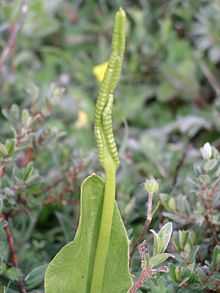Ophioglossaceae
| Ophioglossaceae | |
|---|---|
 | |
| Ophioglossum vulgatum | |
| Scientific classification | |
| Kingdom: | Plantae |
| Division: | Pteridophyta |
| Class: | Psilotopsida |
| Order: | Ophioglossales |
| Family: | Ophioglossaceae C. Agardh |
| Genera [1] | |
| |
Ophioglossaceae, the adder's-tongue family, is a family of ferns, currently thought to be most closely related to Psilotaceae, the two together comprising the class Psilotopsida as the sibling group to the rest of the ferns. The Ophioglossaceae is one of two groups of ferns traditionally known as eusporangiate ferns. The number of genera included in the family varies between different authors' treatments, and most conservatively the family is treated as containing four genera, Ophioglossum, Botrychium, Helminthostachys, and Mankyua (placed in two to four separate families in other treatments). A broad definition of the family and its genera have been taken in several recent treatments.[2][3] A notable exception is the classification of Kato, who advocated the division of Botrychium into four genera: Botrychium s.s., Sceptridium, Japanobotrychium, and Botrypus.[4]
These ferns differ from the other ferns in several respects:
- they produce only a single leaf at a time
- instead of the leptosporangia typical of most ferns they produce eusporangia, which are larger, contain more spores, and have thicker walls
- their sporophylls are divided into two distinct parts, the sporophore which produces sporangia and has a greatly reduced and modified blade, and the trophophore, which is very similar to the trophophylls in size, color, shape, and so forth
- their gametophytes are subterranean and rely on fungi for their energy (in other words, they are mycoheterotrophic), unlike the terrestrial, photosynthetic gametophytes found in most ferns.
Members of Ophioglossaceae are usually terrestrial (excepting a few epiphytic species of Ophioglossum) and occur in both temperate and tropical areas. The leaves are usually fleshy, and in temperate areas will often turn brownish or reddish during colder months. In addition to having mycoheterotrophic gametophytes, there are a few members of Botrychium that are unique among ferns in having the sporophytes also mycoheterotrophic, producing only small, ephemeral sporophylls that do not photosynthesize.
| Wikimedia Commons has media related to Ophioglossaceae. |
References
- ↑ Genera Tropicos.org. Missouri Botanical Garden. 15 Jan 2012
- ↑ Wagner, WH (1990). "Ophioglossaceae". In Kramer, KU; Green, PS. Pteridophytes and gymnosperms. The families and genera of vascular plants 1. Berlin: Springer-Verlag. pp. 193–197.
- ↑ Smith, AR; Pryer, KM; Schuettpelz, E; Korall, P; Schneider, H; Wolf, PG (2006). "A classification for extant ferns". Taxon 55 (3): 705–731. doi:10.2307/25065646.
- ↑ Kato, M (1987). "A phylogenetic classification of Ophioglossaceae". Gardens Bulletin (Singapore) 40: 1–14.
- C.Michael Hogan. 2010. Fern. Encyclopedia of Earth. National council for Science and the Environment. Washington, DC
- Ophioglossaceae in Flora of North America (incl. Botrychiaceae)